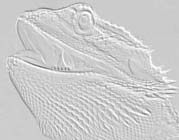 |
 |
|||
 |
||||
|
There have been a lot of questions regarding live feeders such as crickets, worms, and mice that are used as feeders for our reptiles, and whether bacteria or parasites might be introduced to them through those feeders. Is it possible that they can enter the reptiles this way? The answer is yes, not only possible, they can be deadly to them as well. Like any live animal, insects and feeder prey need proper care to be healthy. Short changing them on good diet, nutrition, and cleanliness can harm your beloved pet. Crickets and worms are not bad for reptiles, but they can harbor bacteria and fungus if not cared for properly, especially if being fed foods that mold easily. Corn base feeds are particularly susceptible to mold, the most common found is Aspergillus B. Insects are capable of storing these hepatotoxic substances in their tissues and showing no ill effect, but when those insects are fed to reptiles over time, it causes chronic mycotoxicosis, leading to hepatocellular lipidosis, most commonly found in lizard species and one of the leading cause of unexpected deaths in them. Lab test have showed that both rodents and crickets can harbor many types of bacteria, both gram negative and gram positive, that can cause serious illness. Some things found in pathology reports on crickets are: Citrobacter
Freundii Rodents have been found to be the intermediate host of many parasites that can infect reptile species, especially nematodes. I have not received any pathology reports that show coccidia is transferred from crickets to reptiles, but personally I believe although they cannot reproduce inside a cricket, they certainly are carried on the body or legs of the crickets. This is why I recommend that crickets never be recycled back into a tub or keeper, if they have been in with a reptile, consider them contaminated and dispose of them. How can you guard against problems like this? For starters, learn the care and testing that the supplier you buy from does on their feeders. Some cricket farms regularly have their crickets tested at university labs to assure they are disease and bacteria clean. In talking to one of the farms, we learned that they totally gut a house they are raised in between breeding cycles, including using backpack flame throwers to clean and sterilize metal walls, concrete floors, and metal ceilings. All furnishing for housing the crickets are sterilized also or are disposable and replaced each cycle. Care for your feeders at home with the same care your give your reptiles, change water and food daily. Do not let food sit that can spoil, get damp or mold. On one forum I saw someone advising others to mist their crickets daily, you can imagine the damage that can do, especially as they walk through their food and get that moisture in it. Many dry cricket foods (which I think are the best for them) are corn based, and must be cleaned and changed daily to avoid the problems mentioned above. Use damp sponges placed in lids separated from the dry food or vegetables that contain moisture, remove and clean them daily. Above all, if you use a substrate, that some recommend, change it often, or it will harbor bacteria and parasites. I recommend using nothing as a substrate for crickets, and use egg cartons or drink holders for the crickets to hide in. They are easy to keep clean this way, all you need to do is use a small wisp broom every few days to clean out the shed and droppings. Most illness in reptiles is from the husbandry of not only them, but also what you fed them. Problems can be controlled by the owners' care if they are aware of them. Many diseases and parasites, that affect reptiles, are introduced by the owners either through feeder care or substrates used in their habitats.
Written by Cheri S. of ReptileRooms for Beautiful Dragons. |
||||
|
Copyright
© Beautiful Dragons. All Rights Reserved.
This website may not be copied or reproduced without my permission. |
||||